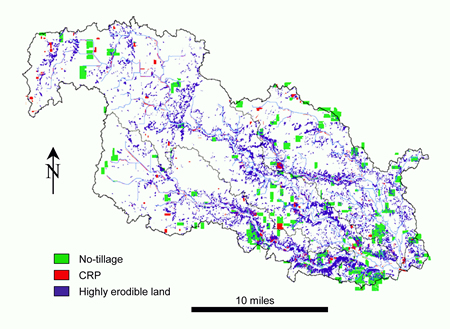Watershed Highlight 3: Evaluating Targeting of Conservation Practices in the South Fork Watershed
The Conservation Title of the 1985 Farm Bill (Food Security Act) included provisions to reduce soil erosion on highly erodible land (HEL) through conservation practices such as Conservation Reserve Program (CRP) plantings and reduced tillage. Land enrolled in CRP was planted to perennial, non-harvested vegetation for at least a ten-year period in exchange for annual rental payments. Soil survey data, including slope, soil texture and depth are used to identify HEL. Those producers farming on HEL-dominated fields were to employ reduced tillage practices to remain eligible for USDA commodity programs; this was known as the conservation compliance provision of the 1985 Farm Bill.
A one-time inventory of conservation practices in the South Fork watershed was conducted during 2005. We compared the distribution of no-tillage management and CRP plantings with the distribution of HEL, which occupies 12% of the watershed (Figure 7).
|
Figure 7

Distribution of key conservation practices for erosion control in the South Fork watershed, compared to the distribution of Highly Erodible Land.
Very little (2.4%) of the watershed's cropland had been enrolled into CRP by producers, partly because this is some of the most productive rain-fed agricultural land in the U.S. While CRP has also been used to install buffers along streams and around livestock facilities, there has been apparent success in targeting of CRP towards HEL. That is, the proportion of HEL in the watershed in CRP is 4.6%, as opposed to only 2.2% of non-HEL (Table 2).
|